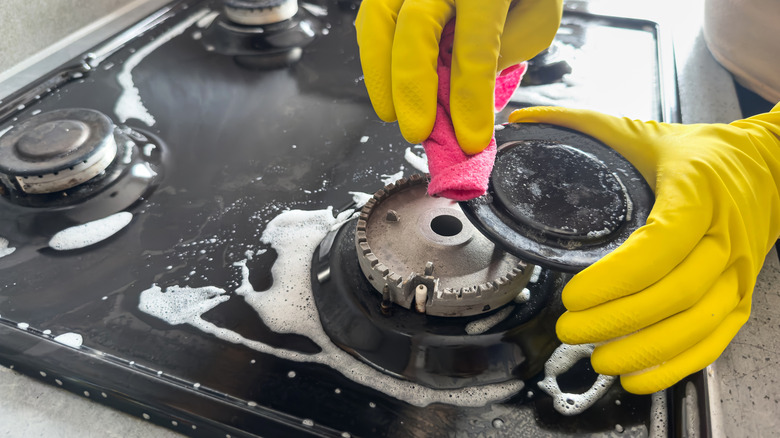The Food Safety Difference Between Cleaning And Sanitizing Your Kitchen
One of the most high-traffic areas in the household is the kitchen, which is why regular cleaning and sanitizing are such important practices for helping folks stay healthy and lowering chances of exposure to a virus or bacteria. Though they may sound like basically the same thing, there are distinct differences between cleaning and sanitizing: Think of sanitizing as an extra step after cleaning.
Cleaning is motivated by dirt, grease, and grime removal, while sanitizing is motivated by germ and bacteria neutralization. In other words, spraying bleach on the countertop after slicing up a raw eye of round is a different practice from scrubbing a year of built-up oil from the range hood above your oven. They're preventative tasks completed with different targets in mind, but cleaning and sanitizing do have some utilitarian overlap. Happily, the physical act of cleaning alone takes care of removing most germs and harmful bacteria from various kitchen surfaces. Scrubbing with soap and detergents can be enough to keep foodies safe on a regular day-to-day basis.
Cleaning kitchen surfaces regularly, as needed, or when they've become visibly dirty is part of routine home maintenance. But, a more thorough sanitization might be necessary after anyone in your household has recovered from a contagious illness, if a product inside your refrigerator has been recalled, or if your kitchen countertop or cutting board came into contact with raw meat.
Cleaning is about dirt and grime, while sanitizing is about germs and bacteria
Any time you're using hot soapy water, mild detergent, a vacuum cleaner, duster, degreaser, or glass cleaner, that's cleaning. Cleaning must always happen before sanitizing can take place. Sanitizing only happens when employing a specific product designed for killing germs and microorganisms. Per EPA regulations, a product must be able to remove 99.9% of germs in order to be designated as a sanitizer. Sanitizing solutions can be purchased in stores and will be printed with specific directions for safe and effective use; these directions should be followed carefully.
For deep cleans, different products like diluted bleach sprays and sanitizers will be necessary to effectively reduce surface dwelling germs to safe levels. In public spaces like restaurants, offices, and school cafeterias, surfaces are often sanitized multiple times per day. In the home kitchen, any surfaces or objects that come into frequent, direct contact with mouths, hands, or food should be sanitized semi-regularly (take that as strictly or loosely as you prefer). That means countertops, cabinet knobs, appliances, utensils that sit out on the countertop, the oven, and the sink can benefit from a quick spray. You can even sanitize your kitchen sponge (and probably should). Once your space is satisfyingly clean, feel free to dive in with some of Ina Garten's top tips for kitchen organization, or even try your hand at "fridgescaping" (if you're into that sort of thing).

